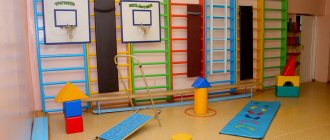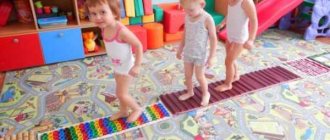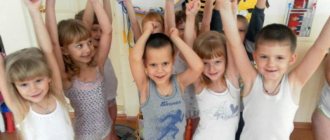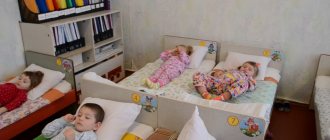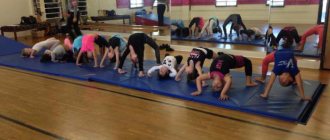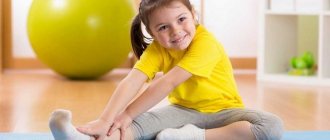Why sleep is important
As you know, a person spends a third of his life sleeping. We all understand perfectly the importance of quality and good sleep for the harmonious growth and development of a child. In cases where the baby does not get enough sleep, his behavior may change, irritability, capriciousness appear, aggression may occur, and the child’s communication with the outside world is disrupted. It is more difficult for such children to establish contact with peers, they have a reduced desire to understand the world around them, and it is more difficult for them to realize their intellectual potential.
Sleep is necessary to accumulate energy and strength that are expended during wakefulness. During sleep, information is sorted, new skills are learned, and emotional experiences are analyzed. The main functions of sleep are: energy conservation; maintaining the level of consciousness and thermoregulation; Neuron maturation occurs during sleep; complication of intercellular interaction of the brain.
Gymnastics for children 3-4 months old
In order to avoid repetition, we will add to the above exercises a description of new elements of gymnastics.
Breathing exercises
Starting position: on your back. Simultaneous movement of the arms up and down and circular movements with the arms are added.
Boxing exercise
Starting position: on your back. With your arms bent at the elbows, they are alternately straightened. The movements are reminiscent of boxing. Important! The handles are fixed in the wrist joints to prevent sprains.
Half-turns and turns from back to stomach and back
Starting position: on your back. One hand clasps the child's shins from below, the index finger of the adult's other hand is placed in the baby's palm, and the remaining fingers cover his hand. Then, slightly straightening the child’s legs, you should turn his pelvis, after which the child turns his head and shoulder girdle. Make turns in both directions in a similar manner.
Exercises on the ball
Starting from 3 months, you can introduce a new type of activity - exercises on the ball. For these exercises you will need a ball with a diameter of 50-60 cm, slightly deflated.
Swinging on the ball promotes the development of coordination, the vestibular apparatus, and helps to tone the abdominal muscles, back, and legs.
The baby is placed on the ball in different ways: on the back, on the tummy, and alternately on the sides.
Swings are performed with support on the legs, with legs raised.
It is important to remember to securely secure the child on the ball.
Sleep phases
Sleep is a heterogeneous process, consists of 4 phases, and is a sequence of functional states of the brain - the phase of slow sleep (sleep without dreams) and the phase of rapid sleep (sleep with dreams, or REM phase). There are two main rhythms associated with sleep:
- Ultradian rhythm is a cycle of different phases of sleep: slow and fast.
- Circadian rhythm is the cycle of sleep and wakefulness during the day.
A child's sleep is different from an adult's; it is more superficial and sensitive. In children, most of the sleep is REM sleep, but in adults, REM sleep is only 25%. During the REM sleep phase, you can observe how the child's eyeballs move under closed eyelids. At this time, the child dreams.
Sleep is “directly” related to the body’s “biological clock”. The rhythm varies throughout the night and lasts on average about an hour in infants and about an hour and a half in adults, with imperceptible awakenings occurring between sleep stages. A typical 8-hour sleep consists of 4-6 wave-like cycles.
The child's sleep-wake rhythm refers to circadian (daily) rhythms, which exist outside of environmental influences, but are subject to external modulation and can adapt to external factors. The establishment of circadian rhythms occurs during the first year of life and directly depends on the maturity of the infant’s neuroendocrine system. Therefore, it is extremely important to form the correct sleep-wake system, and the child’s eating behavior serves as a kind of moderator of the cycle.
If sleep is not enough
All children are individual and grow and develop differently. The state in which the child spent the night further determines his ability to implement his life program. And the amount of sleep a baby needs is related to its growth rate.
The duration of sleep varies for each child, depending on temperament, psychophysiological state and a number of other reasons. Babies sleep about 80% of the time, and at 1 year of age, a child sleeps about 12 hours as the process of “maturing” the nervous system slows.
Average statistical standards for sleep during the day in young children are presented in the table:
| Age (months) | Duration of sleep per day (hours) |
| 2-3 | from 10 to 23 hours (short naps 2-4 times during the day) |
| 3-4 | from 8-10 hours to 11-12 (short naps 2-3 times during the day) |
| 6-12 | 11-12 (night sleep) (short nap during the day 2-3 times) |
| 12-18 | 8-12 (night sleep) (short nap during the day 2-3 times) |
Some children, due to their individual characteristics, require less sleep than their peers. And if a child sleeps less or more than the average, but feels and behaves well, then there is no need to worry.
Methods of performing invigorating gymnastics after naps for preschool children
Invigorating gymnastics after nap for preschool children
requires precise execution of simple exercises. The teacher must explain in detail to the children how and what to do, and help if necessary.
It is useful to include physical exercises on the bed, on the floor, breathing exercises, walking along massage paths, and exercises to prevent posture.
The exercises are performed first in bed, then in a cool room.
You can perform several simple exercises in bed.
Its main task is for the baby to wake up in a good mood.
“We’re almost all awake now”
Target:
promote a gradual transition from sleep to wakefulness. Carry out preventive work to strengthen the arch of the foot and form correct posture. Improve your walking, running and outdoor skills at a general pace. Continue to learn to monitor your breathing. Strengthen children's health. Cultivate a conscious attitude towards maintaining and strengthening your health.
Awakening gymnastics
Awakening is one of the most important moments contributing to the normal course of vital processes for the child. For this purpose, after daytime sleep, gymnastics is performed in bed; it is aimed at a gradual transition from sleep to wakefulness. Children wake up to the sounds of smooth music. We start doing gymnastics with the children who wake up, the rest join in as they wake up. It includes elements such as stretching, alternately raising and lowering arms and legs, elements of finger exercises, eye exercises, and elements of breathing exercises. The main rule is to avoid sudden movements that can cause muscle strain, overexcitation and, as a result, dizziness. Gymnastics after a nap is also a hardening procedure. The duration of gymnastics in bed is 2-3 minutes. Next, children proceed to perform a set of breathing exercises, which is very important for the prevention of colds and diseases of the upper respiratory tract. Then hardening activities are carried out using the “health track”. The total duration of health-improving gymnastics after daytime sleep should be 12-15 minutes. Exercising after sleep should not be long and tiring.
Give a boost of energy for the afternoon
Method of performing invigorating gymnastics after sleep
Gymnastics after a nap should help the child wake up and return to the working rhythm of the day.
To wake up quickly, but not abruptly, use some simple principles:
- There is no need to wake up the child on purpose. He should wake up on his own, to calm music and the quiet voice of the teacher;
- It’s better to start with finger exercises, self-massage, simple exercises in bed;
- Before classes, ventilate the room well;
- Gymnastics should not be tiring, children should finish it in a good mood. But there will be no benefit from classes that last less than 15 minutes;
- It is best to complete the exercises with hardening procedures. Healthy children can wipe themselves with cool water, children after illness can simply wash themselves;
- Gymnastics should be carried out in a playful way, and exercises should be selected so that the child can cope with them. If it is difficult for your child to perform certain exercises, help him, and, of course, do not scold him in any way.
A set of invigorating gymnastics exercises after sleep in bed No. 1
1. exercise: “Eyes wake up.”
Lightly rub your eyes,
And then we yawn sweetly.
IP: lying on your back, arms along your body. 1-4 lightly stroke your closed eyes, 5-8 make a relaxing yawning sound. D – 8. T – slow.
Exercise 2: “The head woke up”
We're almost awake
And they smiled at each other.
IP: lying on your back with your arms along your body. 1-2 – turn the head on the pillow to the right, 3-4 – i.p., 5-6 – turn the head on the pillow to the left, 7-8 – i.p. smile at each other when you turn your head. D – 8. T – slow.
Exercise 3: “Hands woke up”
We stretched out a little
Hello sunshine in the window!
IP: lying on your back with your arms along your body. 1 – raise your right hand up, 2-3 – pull your right hand up, 4 – lower your right hand onto the bed, the same for the left hand. D – 8. T – average.
Exercise 4: “Legs woke up”
We also want to stretch
And completely, completely wake up.
IP: the same. 1 – raise the right leg straight up, 2-3 – pull the right leg, 4 – lower the right leg, the same for the left leg. D – 8. T – average.
Exercise 5: “The legs are completely awake.”
We'll shake our legs
And we will count to three. I.p.: lying on your stomach with support on your elbows, carefully support your chin with your palms. 1-8 – alternately bend and straighten your knees. D – 8. T – average.
Gymnastics complex after sleep No. 2 in bed
1. “We woke up”
I. p.: lying on your back, legs together, hands behind your head. V.: 1 – raise straight legs and arms up in front of the chest. 2 – spread your arms and legs to the sides. 3 – bring your legs and arms together in front of your chest. 4 – return to the starting position. (repeat 4 times, moderate tempo)
2. “We are skillful”
I. p.: lying on your stomach. V.: 1-2 - bend your legs at the knees, grab your ankles with your hands, bend over. 3-4 – return to the starting position. (repeat 4 times)
3. "We're nimble"
I. p.: sitting, legs straight together, hands on shoulders. V.: 1-2 – forward bend. 3-4 – return to i. p. (repeat 4 times)
4. “We are resilient.
» I. p.: sitting, legs straight together, hands on shoulders. V.: 1-2 – raise straight legs up, at the same time raise your arms up. 3-4 – return to i. p. (repeat 4 times)
Gymnastics complex after sleeping on the floor
"Zainka - little bunny"
1. “Little bunny, cheer up, little gray one, stretch.” I. p.: standing, arms along the body. Rise up on your toes, arms out to your sides. 2. “Little bunny, turn around, little gray one, turn around” I. p.: standing, hands on your belt. Turn the body left and right, then i. p. 3. “Little bunny, dance, little gray, dance” I. p.: the same. Soft spring. 4. “Bunny, bow, little gray one, bow.” I. p.: the same. Bend the torso forward. 5. “Little bunny, walk around, little gray one, walk around” I. p.: the same. Walking in place. 6. “The bunny walked across the bridge” Walking on a ribbed board. 7. “Yes, over bumps, yes over bumps.” Walking on rubber mats.
Breathing exercises
“Here is a tall pine tree standing and moving its branches.”
I. p.: o.s. 1—inhale—arms to the sides; 2 - exhale - tilt the body to the right; 3 - inhale - return to the first position; 4 - the same to the left.
"Dandelion".
I. p.: sitting, legs curled up, back straight, arms bent at the elbows and raised up. Perform finger exercises “Fingers say hello” (“little finger to little finger...”), then say: “Blow on a dandelion, on a little white flower. Blow, blow harder, and you will become healthier,” and, taking a deep breath through your nose, blow on your hands (“dandelion”).
"Geese."
As you inhale, bend forward: looking forward and stretching your neck, say “sh-sh-sh.”
"Pump".
Taking a breath, bend sharply as you exhale, sliding along your leg with both hands, and say “ssss.”
"Hedgehog".
I.p.: sitting, legs together, arms supported behind. Bend your knees and pull them towards your chest. Straighten your legs (“f-f-f”)
"Woodcutter".
Hands clasped above your head in a “lock”, feet shoulder-width apart (raising your hands up, take a deep breath through your nose), as you exhale, bend your torso forward while simultaneously lowering your arms and saying “wow!”
Breathing exercises:
"Balloons".
Perform while walking around the site. 1 - arms to the sides, up, inhale through the nose, clap your hands (“the ball burst”); 2 - arms to the sides, down, saying “s-s-o” or “sh-sh-sh” (“the ball has gone down”).
"Tiger on the hunt."
Walking around the site, put your right (left) leg forward, place your two hands with your palms on your knee, arching your back. Take two to four sharp breaths, head raised (“tiger is looking for prey”).
"Cockerel."
As you inhale, rise on your toes, pull your head forward, raise your arms to the sides, and move them back. As you exhale, slap yourself on the thighs (“cuckoo-ka-re-ku”).
“I’ll grow big.”
I. p.: feet together, hands down. Rising on your toes, pull your arms up (inhale). Lowering your entire foot, exhale “uh-uh-h.”
"Stork".
As you inhale, raise your arms to the sides. Bring the leg bent at the knee proudly forward and fix it. As you exhale, take a step. Lower your leg and arms, saying “sh-sh-sh.”
"Mill".
Inhale and rotate with straight arms, saying “zhr”
“Lotus”.
I. p.: sitting cross-legged, shoulders slightly pulled back, head raised, hands resting with the back of the hand on the knees, index and thumbs closed in rings. Inhale through the diaphragm (shoulders do not rise), imagine a stream of air penetrating the entire spine to the top of the head, exhale slowly through the mouth (can be done with eyes closed).
"Train".
Walk, imitating the movement of the wheels of a steam locomotive with bent arms, and say “chuh-chuh-chuh.”
"Hanger."
I. p.: o. p., look straight ahead. Slightly tilt your head to the right, your right ear goes to your right shoulder - take two short noisy breaths through your nose. Then slightly tilt your head to the left, the left ear goes to the left shoulder - also inhale (“the ear and the shoulder say hello”).
"Balloons".
Perform while walking around the site. 1 - arms to the sides, up, inhale through the nose, clap your hands (“the ball burst”); 2 - arms to the sides, down, saying “s-s-o” or “sh-sh-sh” (“the ball has gone down”).
Breathing exercises:
"Walk in the Woods"
“In a hanging cradle in the summer, a forest dweller sleeps”
(nut). I. p.: lying on your back, arms along the body. 1 - inhale; 2 - exhale - sit with straight legs, hands to toes; 3 - inhale; 4 - exhale, return to i. P.
«Here the Christmas tree has bent its green needles.”
I. p.: legs apart, arms down, hands to the sides. 1 - inhale; 2 - exhale - tilt the body forward; 3-4 breaths - return to IP. - exhale.
“Here is a tall pine tree standing and moving its branches.”.
I. p.: o.
s., 1 - inhale - arms to the sides; 2 - exhale - tilt the body to the right; 3 - inhale - return to i. P.; 4 - the same to the left. “Let’s blow on your shoulder.”
I. p.: o. s., look straight ahead, hands on your belt. Inhale through your nose and turn your head to the right side, exhale (lips through a tube) - blow onto your shoulder. Do the same on the left side.
"The flower is blooming."
I. p.: standing, hands on the back of the head, elbows together (unopened bud). Slowly rise on your toes, pull your arms up and to the sides - inhale (“the flower opens”), return to the etc. (exhalation).
“I’ll grow big.”
I. p.: feet together, hands down. Rising on your toes, pull your arms up (inhale). Lowering your entire foot, exhale “uh-uh-h.”
"Angry hedgehog."
Bend down as low as possible, clasp your chest with your hands, lower your head, pronouncing the sound of an angry hedgehog “p-f-f-f-r-r”.
"Hello Sunshine".
I. p.: feet shoulder-width apart, hands behind your back. Slowly raise your arms up, sliding along your body, arms to the side, lift your head up (inhale), slowly return to i. P..
Why does a child sleep restlessly
A peculiarity of a baby’s sleep in the first month of life is that after falling asleep, the baby immediately goes into the slow phase. At what age do children dream is still a controversial topic; babies begin dreaming immediately after falling asleep. During such sleep, the child’s brain works faster, sometimes even stronger than when awake, and is accompanied by increased activity - movements of the legs and arms are noted, which can alert parents.
To create a comfortable system for sleep and rest for a child in the first month of life, it is necessary to create silence, preventing street noise from entering the room, turn off or mute the sound of a working TV; remove bright room lighting, it is advisable to close the windows with thick curtains to exclude access to bright sunlight; at night it is permissible to use a dim night light.
Gymnastics for children 4-6 months
Unconditioned reflexes gradually fade away, so the proportion of passive-active exercises increases. The number of repetitions of the same exercise also increases.
Passive exercises are performed - flexion and extension in large joints.
Circular movements in the hip joints, with the obligatory fixation of the child’s knees with your own hands.
Simultaneous flexion - extension of the legs.
Starting position: on your back. You should grab the child's legs at the bottom of the lower leg from behind, holding the feet. Bend your legs at all joints, pressing them lightly towards your stomach (the baby's knees should be spread apart), then straighten the baby's legs.
Connection of opposite and identical knee-elbow.
The range of exercises on the ball is expanding.
At this age, many children swing with interest on the ball while lifting the toy from the surface.
On the ball in a position on the back, you can rock the baby with a slight “squat” when the legs reach support.
From 5 months, you can rock the baby on its side, pushing off the support surface.
What are the types of sleep disorders?
Unfortunately, 6-11% of young children, up to 25% of preschool and school-age children have various sleep disorders. 32% of young children tend to have chronic sleep problems.
The causes of sleep disturbances in a child may be the child’s temperament (excitability, anxiety); physical discomfort characteristic of the course of any disease; consequences of allergic reactions (skin itching, etc.); poor nutrition (feeling hungry); difficult psycho-emotional situation in the family. In newborns and children under 3 months of age, sleep disturbances may be due to intestinal colic; in such cases, it is recommended to use liquid milk porridge with inulin in the diet.
Sleep disturbances can serve as a kind of signal, an attempt to attract the attention of adults, as a signal of discomfort, a signal of pain. A baby's restless sleep can be difficult for parents because it increases family tension, lowers the mother's self-esteem, and increases the risk of postpartum depression.
Organizing your baby's sleep
To organize a proper sleep and rest system for a child in the first years of life, it is recommended:
- Pay close attention to your child’s sleep and rest cycles, and plan your daily routine accordingly.
- It is important to understand that sleep cycles are highly individual and each child has their own unique characteristics.
- Try to time feeding to periods of active wakefulness, rather than drowsiness.
- Give the child a quiet room, separate from the parents' room.
- Learn to recognize signs in a child’s behavior that indicate that he has “fallen out of contact” and is falling asleep.
- Develop a bedtime ritual for the child (rocking, “bedtime story”) to create a feeling of comfort and safety for the child, after which he should fall asleep.
It is important to remember that breastfed babies fall asleep faster, but wake up more often due to the rapid emptying of the stomach. Therefore, it is recommended to use milk for feeding in the evening and at night, which contains the milk protein tryptophan - an essential amino acid involved in the synthesis of biologically active substances, including serotonin, which is involved in the formation of melatonin, which regulates sleep phases and their duration. For milk at night, we can recommend drinking porridge with milk or yogurt.
Gymnastics for children 6-9 months
In addition to the exercises already described:
Breathing exercises are done on your back, on your side, or start while sitting.
Simultaneous and alternate abduction of the arms to the sides, upwards, grasping movements with the arms.
All exercises for the legs are performed: “stomps”, sliding steps, circular movements of the legs, alternating flexion and extension.
A new exercise is introduced: cycling.
Starting position: on your back. With the child's legs bent at the hip and knee joints, circular movements are performed, reminiscent of the movement of the legs while riding a bicycle.
In a sitting position (in a tailor's position, when the feet are joined or in a Turkish position), the child is rocked using a toy and encouraged to stretch after it.
Try in every possible way to encourage your baby to actively turn from back to stomach and back.
An exercise aimed at developing crawling skills is useful. During this period of time, you can help the child by substituting your palm as a support.
Exercises are performed to develop walking: stepping from foot to foot is stimulated, while the adult first supports the child’s armpits, and subsequently, the hands of both hands.
In exercises on the ball: you can use swinging on it in a sitting position.
How to improve your baby's sleep
Proper preparation of the child for sleep is very important. Do not use active games or overexcite the child. You should limit the baby’s psycho-emotional experiences and prefer calm games. It is recommended to bathe children in the bathroom before bedtime 1.5–2 hours before bedtime, then feed and sleep. From birth, a child needs to form the correct circadian rhythm!
Feeding during the day should take place with emotional conversations with the child. When organizing a child’s daytime sleep, there is no need to completely isolate the room from external noise present during the daytime. And vice versa, during night sleep you need to talk quietly (try not to make noise, walk quietly, turn off doorbells, phones, etc.). This order will help the child develop the correct rhythm.
There are several other important rules
At the age of 1 year, the child should sleep separately in his own bed, which, like using a toothbrush, should be individualized.
The bed should only be used for sleeping. Do not keep toys in it. To improve a child’s sleep, it is necessary to create an individual “ritual”. A toy or doll that lies next to the child and gives him a feeling of permanence and stability.
Don't rush to your baby at the first sob. The child, having realized how easy it is to achieve the requirements (drink, eat something sweet), will try with even greater pleasure not to fall asleep.
Don't punish your child by sending him to bed. Getting ready for bed should be a joyful and pleasant situation.
Create a bedtime ritual. You can read a fairy tale before bed, listen to calm music, put on pajamas, etc. Such a ritual can take 15–30 minutes and the child will properly prepare for bed.
Child's sleep from 2 to 5 years
To organize a proper sleep and rest system for a child aged 2-5 years, it is recommended:
- When putting your child to bed, you need to be firm and consistent, adhere to the established ritual, making him feel that this is not a whim, but an objective necessity.
- Before going to bed, you should avoid excessive physical activity, games, arguments, and scary stories.
- A night light or favorite toy and pleasant music will help your child fall asleep.
- If a child has nightmares, he should be reassured, told that his parents are nearby, and returned to his bed.
- Sleep disturbances occur due to the fact that the child enters a new period of development and begins to experience certain difficulties associated with separation from parents, and aggression as a manifestation of anxiety associated with this separation.
- The appearance of night fears and nightmares can be facilitated by: the birth of a second child in the family, moving to another apartment, a scary movie.
- The child should spend a lot of time every day in the company of his parents so that he does not have an urgent need for their attention when he needs to go to bed.
In preschool children and adolescents, sleep disturbances are largely caused by psycho-emotional stress, problems at school with parents, and falling in love for the first time. Therefore, it is very important to find and correct the situation.
In the correction of sleep disorders in children of different ages, the correct routine and educational aspects and proper organization of nutrition are decisive. Prescribing medication to correct sleep problems should be discussed with your doctor if sleep problems begin to affect your child's mental or emotional development. The existence of a correct sleep-wake rhythm is the key to the normal harmonious development of the baby.
Gymnastics for children from 0 to 3 months
The optimal age at which it is recommended to start a course of massage and gymnastics is discussed in the article “general principles of massage.” Massage and gymnastics for children of the first year of life
Breathing exercises
Breathing exercises are very important for babies of this age. They promote the development of respiratory muscles, the physiological abilities of the respiratory system, its reserve capabilities, and serve as the prevention of respiratory diseases.
Starting position: the child is in the mother’s arms, facing her. Apply rhythmic pressure with the palm of your hand on the child’s back, moving the palm from the neck to the lower back.
Starting position: the child lies on his back. Alternately moving the handles to the side and up, starting from three months you can perform this exercise with two handles at the same time.
Reflex exercises
Infants have a certain physiological feature of the nervous system - the presence of unconditioned reflexes that appear and disappear at certain times.
Thus, a special group of exercises can be distinguished for infants. These are reflex exercises. They are based on the special evocation of certain unconditioned reflexes.
Naturally, no one will induce the Moro reflex as an exercise (a loud blow on the surface on which the child is lying, while he makes a “hugging” movement).
But some of them, for example the Babinski reflex (special stroking of the foot) or the support reflex are very useful as developmental exercises.
The number of repetitions of reflex exercises during the lesson is 1-2 times.
The exercise is based on the Babinski reflex.
Starting position: the child lies on his tummy.
Apply pressure on the sole at the base of the toes - the child will reflexively bend the toes, then move along the inner edge of the foot to the heel and the outer edge to the little toe - the sole is extended. The movement is performed with the adult's thumb. Repeat 1-2 times. Important! When performing the exercise, the child’s leg is always fixed at the ankle joint (not at the toes).
Reflex exercises at this age also include reflex crawling, reflex support and reflex walking. These exercises are usually carried out at the end of the lesson.
Reflex crawling
The exercise is based on the Bauer crawling reflex.
Starting position: on your stomach. An adult’s palm is placed under the child’s feet, so that the child can rest his slightly bent legs against it. The child pushes and straightens, moving forward. Repeat 1-2 times. Important! Don't forget to leave a clear space where the baby will make this movement (so that he doesn't hit his head).
Reflex support and walking
Starting position: the child is in an upright position, the adult’s hands are in the child’s axillary areas. The child should be allowed to rest his feet completely on the surface of the table. Slightly tilt the child's torso forward, and he will reflexively take several steps.
Laying on the stomach is useful; this is also an exercise for the child, based on the protective reflex (the baby raises and turns his head to the side). In the “on the stomach” position, the muscle tone of the extensors is stimulated, the abdominal muscles are toned, the work of the intestines is stimulated - the removal of “gas” is facilitated, and it prevents constipation.
Laying on the stomach is recommended daily, starting from 30 seconds and up to 15-20 minutes in the first months of life.
Passive exercises
Sliding steps - “stomp”
Starting position: on your back. The leg is bent at the knee and hip joints, the foot rests on the table, and the foot slides along the surface of the table.
Riding in the “embryo” position.
Starting position: the child lies on his back. The legs are bent, brought to the tummy, the head is also bent, the chin is brought to the chest. The baby is “rolled” in this position on his back. As a rule, children really like this exercise.
Active exercises
Various bright, sounding toys are used, which are shown to the child at a distance of 25-30 cm, thus stimulating eye tracking of an object, auditory concentration, and an attempt to grasp the object.
